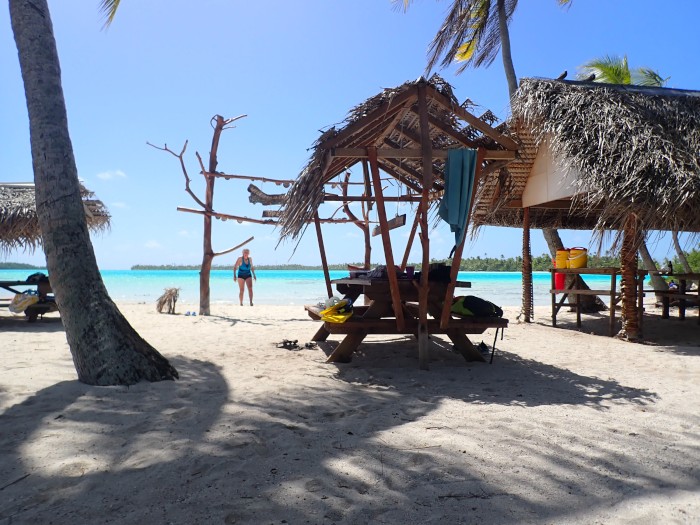Blue Lagoon Summer Camp
10 September 2022
• Rangiroa
by Karl Coplan

One of the big scenic attractions that brought us to Rangiroa is the “Blue Lagoon” - a shallow lagoon renowned for its idyllic setting and brilliant turquoise waters.
The Blue Lagoon is at the southwest edge of the atoll, which means that the approach has an open fetch to the east of about forty miles. You can not take a sailboat into the lagoon, as it is surrounded by shallow coral reefs. Some cruisers have been able to anchor outside and take their dinghies in, but that requires very calm weather, as the forty mile fetch in the atoll makes anchoring impossible with any sort of easterly wind.
We had hoped that by staying a week we might have one day of calm winds and sail to the blue lagoon in the Mabel Rose. But the calmest day turned out to be last Sunday, when we arrived, and the long term forecast continued to show vigorous easterly trade winds every day for the next week.
So we called the same number we had called for the va’a lessons, and arranged for a tourist boat excursion to the “Lagon Bleu.” Jean Pierre asked for the name of our boat, and told us to wait on board for a pick up at 845 “samedi.”
That was today, and at 0900 the bright red outboard passenger launch arrived, with our va’a instructor Opura at the helm and his mariner Moro at the bow. We said our ioranas and smiled to see our friend again. “Il y’aura des autres?” I asked, looking at the empty launch. Yes, yes. So we stopped at the Kia Ora hotel dock to pick up the other tourists, two young Italian couples and a Polynesian family with fresh leis from the airport.
We zoomed down the wave trains for the twenty mile trip to the lagoon entrance, and Opura moored the boat on the shallow coral reef and indicated we should all jump into the water and wads to shore. Opura said not to worry about the sharks, they would not bother us, but to watch out for coconuts. They were dangerous. Moro pulled a plastic dinghy ashore with our bags.
Welcome to Camp Lagon Bleu! Palm thatched shelters with picnic tables were identified by the name of the tour operators, and the clear blue waters of the lagoon beckoned. Opura motioned to Robin and me and said, “If you want to take a walk to the other islands, you should go now, because it will be very crowded soon.”
So we waded across to the next motu, and the one after, and the one after that to find an island that was deserted except for the nesting black noddys. We enjoyed our solitude for about fifteen minutes before we saw the next landing parties advancing, and we decided just to wade back to “our” motu and go snorkeling.
After we came ashore from snorkeling, I noticed the black tipped sharks gathering by our beach, while the fish for lunch were grilling. I asked Opura whether the sharks knew what time to come to be fed, or whether they smelled the food. He smiled, and said, “Ils sensent les Americains.”
Next on the schedule was a coconut tree climbing demonstration by Moro, and a hat weaving demonstration by Opura. Then lunch. I said to Opura - you are captain, va’a athlete, and chef, too. Opura said there is a saying that “Polynesians sont polyvalent” - Polynesians are multitalented.
Shark feeding was after lunch, then serious relaxation, then we waded back to the launch for the very wet wave slam back to town. Robin and I were the only ones to accept the spray slickers Moro offered. We also chose the wettest seats on the boat.
The tour included a snorkel stop at the “aquarium” by Tiputa pass - we thought we might sit that out since we had already snorkeled there. It there was a huge school of fish right under the boat, so we donned our masks and fins and rolled over the side of the boat to take a look.
The tour also included a run out Tiputa pass into the ocean to see the resident bottlenosed dolphins, who did not disappoint this time, jumping and flipping and spy hopping in the big seas at the pass entrance. Somehow the waves looked bigger than when we entered last week, even though the tide was flooding and was not causing a break at the entrance,



Comments